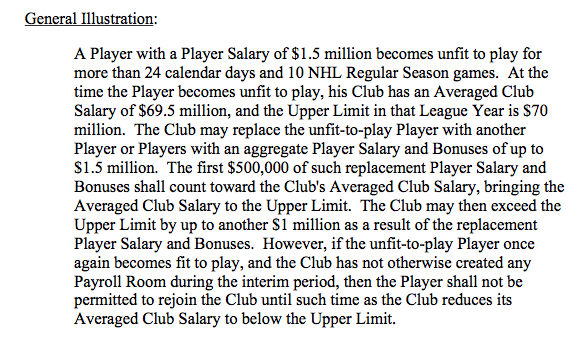Cap implications of Grossmann’s reassignment
By Ryan Pike
7 years agoA common question we received when Nicklas Grossmann was placed on waivers yesterday by the Calgary Flames was about the salary cap implications of his potential assignment to the American Hockey League. With all of the wonkiness and wackiness regarding the long-term injured reserve, cap relief and remaining cap space, we thought we’d dig into it a bit.
Here’s the gist: the LTIR relief is based upon the cap space when LTIR was originally applicable. Presumably Ladislav Smid’s LTIR declaration is retroactive to the beginning of the season; his injury dates back at least that far and it would have to be retroactive in order for the Flames to get the maximum cap relief. The reason that’s important is that once the LTIR is “active,” the cap space used to calculate it stays put.

(The above passage, from Article 50.10 of the CBA, indicates LTIR can be retroactive.)

(This passage from section 50.10 refers to an “interim” period between when a player initially goes on LTIR and when they’re fit to play, which indicates that teams are able to shuffle things underneath that cap relief. It’s the most specific example in the section about whether adjustments can be made.)
On Oct. 12, when the season began, the Flames had $8,266 in cap space. The LTIR relief is defined as the difference between the total cap hit of the player on LTIR ($3.5 million for Smid) and the existing cap space, which would be $3,491,734.
My understanding of the cap space is thus:
- Because the Flames had the cap space they did when LTIR became active (Oct. 12), they can spend up to $76,491,734 – $3,491,734 over the cap due to Smid’s LTIR relief – without penalty. Anything over that, likely due to bonuses on entry level contracts, would come off the cap next season.
- Grossmann’s potential demotion doesn’t impact the cap space in any way. This is either because (a) he was on the roster as of Oct. 12 (when LTIR is likely retroactive to) or (b) he was on the roster when LTIR was enacted, after the Kris Versteeg injury and Hunter Shinkaruk recall.
Now, this is just for illustrative purposes, because the cap is actually calculated daily and is based on averaged NHL salaries across the 180 days of the “playing season.” Grossmann’s been paid $86,250 through the first 27 days of the playing season and his demotion would create about $488,750 in space from now until the end of the season.
Long story short? Because Grossmann was on the roster when the season began and went down when he went down (after LTIR), the Flames’ overall cap relief and total amount they’re allowed to spend does not change. It’s roughly $76,491,734. As long as they don’t violate the 23-man active roster limit, they can send Grossmann down and recall some other players, and their overall cap space does not change.
Recent articles from Ryan Pike




